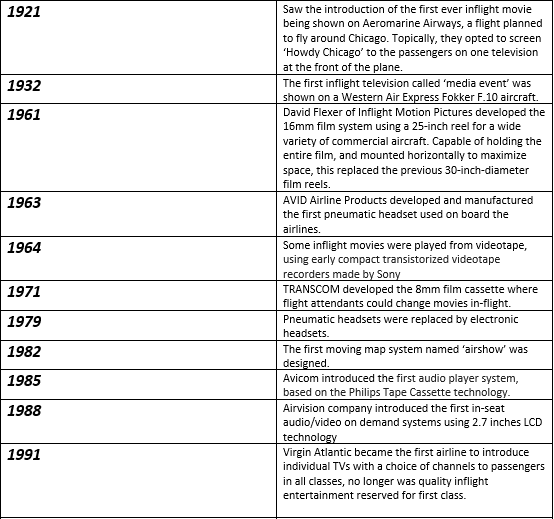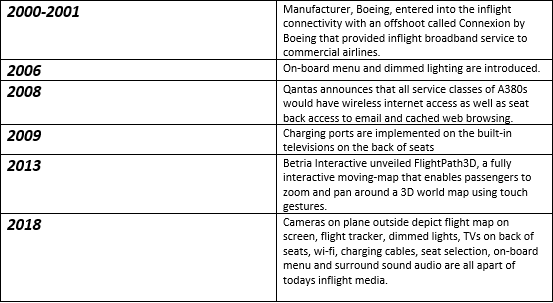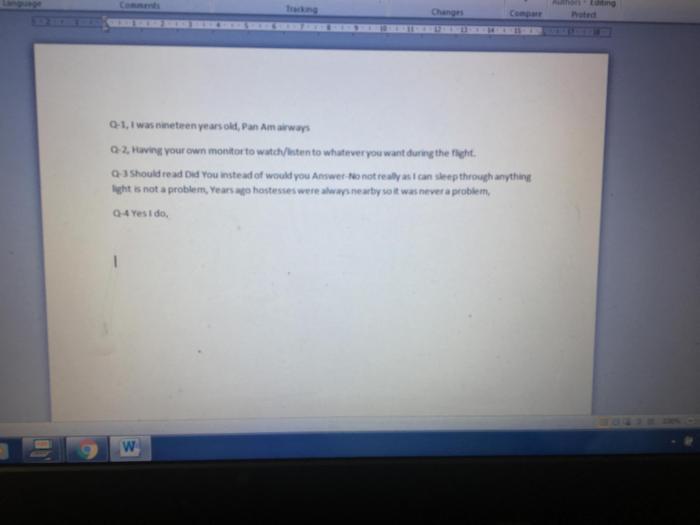For my final project, I decided to conduct an ethnographic study on how inflight media use has changed and developed over time. Today’s modern aeroplanes have sophisticated, high-tech entertainment systems that put movies, television shows, music and games at our fingertips, but this hasn’t always been the case. In the olden days of travel, inflight entertainment options were pretty slim. Most airlines had a central screen that played movies, edited for content, and had audio channels that offered different genres of music. You could listen to all of this while wearing uncomfortable, tube-like headphones that wouldn’t win any awards for sound quality, or if you were bored, you could read magazines, newspapers or your own books.

One example of the greatest airlines today is Dubai’s flag carrier. It was ranked number four on Skytrax’s list of best airlines, but it was number one for in-flight entertainment based on its Ice system. Emirates does not want you to be bored on its long-haul flights, so it offers more than 2,500 channels of movies, TV shows, music, and games, all on demand and in multiple languages. Ice’s digital widescreen even offers movies with audio description and closed captions for those who are hearing or visually impaired. There’s a dedicated channel for eSports enthusiasts and the chance to brush up on your language skills with uTalk videos featuring Arabic, French, German, Italian, or Spanish lessons, plus limited free Wi-Fi on its long-haul flights.
Ethnography Research
“Ethnography is the recording and analysis of a culture or society, usually based on participant observation and resulting in a written account of people, a place or institution”.
There are a number of different types of ethnography, with the primary method being participant observation, as Karen O’Reilly states, ‘ join in with activities in the field and making mental, then written, theoretically informed, observations … use in-depth interviews and conversations’, (O’Reilly, K 2016). Other types of ethnography include fieldwork and observation, online ethnography and collaborative ethnography. By immersing myself in my own research, I have conducted and auto-ethnography where I have analysed my own and other’s personal experiences. Digital ethnography is another sector that I have used through participant observation and interviews with other cohorts.
Background Research
Technology is every changing, however, with the rise in laptops, smartphones and tablets, airlines have begun to anticipate providing inflight entertainment systems that can stream content to passenger’s own devices.
Inside the incredible Emirates first class sweet, with upgraded technology from 10 years ago.
2018 inflight media on airlines:
- Screens built-in on the back of seats
- Larger TVs at the front of each section
- Charging points
- Dimmed lights
- Own light/ fan above seat
- Wi-fi
- Snacks and food cart online
- Seat selection
- On-board menu
- Surround sound audio
- Live flight tracker and flight map/ time to destination/ altitude/ wind speed/ kilometres travelled/ map of the world including day time and night time

Extensive Research
Timeline of how inflight media use has changed over time.


Airline Marketing Materials Over Different Eras In Relation To Onboard Entertainment
‘Airline marketing provides a particularly interesting illustration of the application of marketing principles because it includes examples of both industrial and consumer marketing’, (Shaw, S 2011). Industrial marketing involves marketing to the business air traveller and of air freight services while leisure air travel marketing increasingly exhibits the principles of consumer marketing. Airline marketing has been developed over the past century and is changing every single year, for example, the internet being used as a channel of distribution to target individuals or families who make leisure travel decisions.
Most airlines today are distributed through online marketing such as media advertising on television, offering frequent flyer programs and keeping in contact with travel agents. Fifty years ago, online marketing was not even a source, so airlines were marketed through press such as newspapers and word of mouth.
The future of the commercial aviation market is depicted below.
Airline Marketing Australia (AMA) is able to provide a range of Airline General Sales Agent (GSA) support services specifically tailored to individual airline needs in the Australian market, including:
- Offices across Australia
- Reservations, ticketing, sales and marketing staff
- Sales and marketing, promotional activities
- Customer servicing, call centres
- Distribution, pricing revenue analysis
- Public relations and communications
- Digital marketing
- Consumer and trade events
Inflight entertainment evolved through airline marketing as the first ever screening of a movie was aired in 1921. Nowadays, advertisements are conveyed on the back of seats on the screens as another form of online marketing. The goal of AMA is to:
“Provide our clients with exceptional service and latest technologies that help them succeed in today’s ever-growing travel market”.
AMA provides an advantage with their focused and disciplined distribution systems targeting branded franchises and wholly owned travel agents. Products are distributed to all agency groups via databases linked to Global Distribution Systems (GDS), the internet and email ensure maximum exposure and awareness. The search system reaches all variety of agencies in New Zealand. Retail, wholesale and corporate are just a few of the agency groups that search in the system.
TODAY
Marketing today is mostly done online and on the back of the small televisions. Advertisements are displayed to passengers before their movies begin; this has been on of the greatest transformations in airline marketing with the introduction of inflight entertainment. The content is shown as it is what the passengers want to see – this then grabs their attention.
FUTURE
Future marketing sees airlines having the ability to recommend content to passengers based on what we know about them. That same data analytics will give airlines the ability to target advertising to passengers based on their interests and needs. This may reduce the overall volume of content, and will aim to reduce the volume of advertising. As airlines get to know their passengers better through data analytics, they can provide a more personalised experience.
Examples of how inflight media has transitioned over time.
- What it is like to fly an A330 full motion flight simulator.
The flight simulator is just one example of how technology has transitioned from the 20th century, with a flight simulator that is outfitted with the same technology as planes where you can simulate every type of scenario from zero visibility to engine failure.
2. Stepping inside the world’s most luxurious charter jet.
The world’s most luxurious charter jet conveys 2018’s inflight media such as a fully stocked cabin with bright LED lights that can be dimmed or brightened, electronic business class seats, 24 inch touchscreens with live TV, charging cables, camera views, aircon and heating.
Interviews
- Face-to-face interview with my friend Grace. Grace has been flying for a few years now and has recently returned from flying to the other side of the world. (Need to watch on Facebook. If this logs into my Facebook, please do not watch).
- Me: “How many times have you flown and where’s the furthest?”
- Grace: “Um, probably like 20-30 times and Paris is the furthest”.
- Me: “What inflight media was included on your first flight to Paris?”
- Grace: “Um, they had movies, tv shows, music, games, wi-fi, plugs, earphones”.
- Me: “Do you believe with the constant changing and improvements of inflight media it is really safe? Why/why not?”
- Grace: “I think it’s safe because there’s more advanced technology so they can look after it better, know what’s going on”.
- Me: “Lastly, how has inflight media changed over your time?”
- Grace: “Well, they have upgraded the quality of movies and tv shows that they show, and probably, I don’t know when they introduced wi-fi but probably that”.
2. Text message interview with my Mum, whom then wrote her answers down and sent them to me. My mum has been flying since she was 8 years old and has travelled a few countries.


- Q1) How do you think inflight media use has changed over the past 20 years?
- Q2) What was your first flight like and how did you keep yourself entertained?
- Q3) How did you find not having inflight entertainment such as movies or cameras to see where you were going, did it make you nervous?
- Q4) How has the food and drink catering changed over time? E.g. carts to choosing on-screen.
3. Text message interview with my Dad whom then types his answers on a computer and sent them to me. My dad has been flying since he was a teenager and has flown to more than 10 countries.

- Q1) At what age was your first flight and on what airline?
- Q2) What do you believe has been the greatest transformation of inflight media?
- Q3) Would you ever find it annoying when flying to the other side of the world and the lights wouldn’t dim or you’d have to get up and find an air hostess to ask a question instead of pressing a button today?
- Q4) Do you believe auto-pilot is a safe measure to flying to Boeing-777?
4. Over the phone interview with my twin sister Lauren, she has been flying since her first flight at 3 months old and has flown to the U.K two years ago.
- Me: “How do you think inflight media use has changed in your time?”
- Lauren: “It’s changed dramatically, obviously I don’t remember being 3 months old but back then they never had TVs, flight maps, cameras, music or anything compared to now. It’s scary to think what the future is going to hold since new technologies are always being introduced”.
- Me: “What inflight media do you currently know of?”
- Lauren: “I flew to the U.K. 2 years ago and on my flight I had a whole row to myself, had access to on-board wi-fi, I could dim my light above me, press a button for service, had access to over 100 movies and television shows, could access the flight map that would tell me the altitude and distance until destination. I could also charge my phone and order snacks on my own television. It was pretty cool.”
- Me: “What has been the best and worst airlines you’ve flown with and why?”
- Lauren: “The best would have to be China Airways 100%. I can’t remember where we were coming back from, but the plane was half empty, we had so much room, had access to everything technological possible and it wasn’t bumpy at all – I was actually able to sleep for once because I’m such a nervous flyer, just like mum haha. Vietnam airways were the worst. It was bumpy, there were no TVs and we didn’t get a meal, I mean it was only an hour flight but the service wasn’t that great”.
- Me: “Has every flight included a USB port to charge your devices?”
- Lauren: “I don’t think every flight has. When I was about 7 I remember I wanted to play my DS and I couldn’t charge it because there were no ports. Since times have changed, ever since I was about 12, I think there has been charging points, it’s been great”.
Survey made to analyse other people’s opinions plus a consent form









The reason why I made a survey, was to collect other participants information so I could include the ethnography of participant observation.
Conclusion
Over the last few decades, inflight entertainment systems have seen significant developments, from their initial function as a screen to display an inflight movie to the device that offers live route views and a range of video and audio entertainment options, inflight media has improved extensively over the years. Overall, it is evident that there has been a major transformation of how inflight media has changed over time. Through my ethnographic study, I have made it clear that through interviewing participants, researching extensively and gathering background information, there has been a shift in the technological change of inflight media.